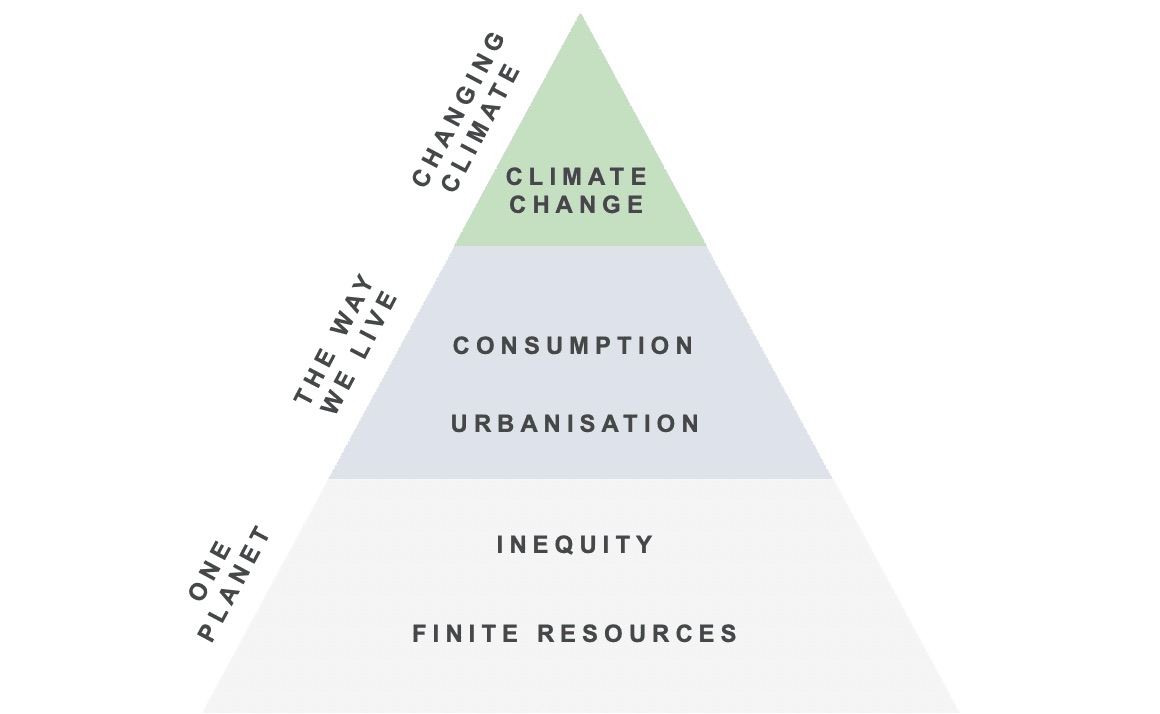
www.buildingsandcities.org/insights/commentaries/adequate-thermal-comfort.html
Providing Adequate Thermal Comfort in a Hotter World

Reducing the need for air conditioning is necessary and feasible.
Edith Blennerhassett (Arup) responds to the Buildings & Cities special issue 'Alternatives to Air Conditioning: Policies, Design, Technologies, Behaviours' . As humane societies, a key aim should be to see the end of deaths due to either heat or cold and to achieve this in a way that minimises the impact on people and planetary health. Actions are highlighted to minimise the need for mechanical cooling.
Built Environment
The micro-climate around a building can have a significant impact on its thermal comfort. Addressing this is a particular challenge for cities and the associated local authorities who are responsible for the public realm.
Provision of climate appropriate vegetation and use of water can deliver shade and evaporative cooling respectively in warm weather as well as assisting in moderating flooding during storm events and providing pleasant spaces that contribute to public well-being. Good landscaping can also improve air quality and reduce city noise impacts.
Properly chosen and placed materials can help to absorb heat during peak times of day and re-radiate it as temperatures cool at night. By contrast, a surface car park will absorb and radiate heat to the local environment and can increase local temperatures significantly with associated impact on surrounding buildings.
Fabric first
From a building perspective, a fabric first approach should be the first step taken in any approach to moderate internal temperatures and minimise the need for artificial cooling / air conditioning. Fabric improvements benefit both the rich and poor and are the only solution in many countries where either economics and / or access to technology prevent access to mechanical cooling. The vernacular buildings in any given country and climate provide strong clues as to how environmental moderation can be achieved by passive means. Examples of this include the large overhangs on the Katsura Palace in Japan, the water features and courtyards of the Alhambra in Granada, Spain or the natural ventilation systems in the UK Houses of Parliament (Schoenefeldt 2022).
Internal space planning should place spaces with highest casual / internal heat gains away from the highest locations of solar gain.
It has become common to provide external solar shading on commercial buildings in the UK and Europe to reduce solar gain and thus cooling demand. This approach should be adopted for other building typologies: schools, hospitals, housing etc. The amount of thermal insulation needed (to reduce heating demand), the amount of solar shading (to reduce cooling demand), the amount of daylight (for wellbeing and energy consumption) and the air tightness of the building (to avoid unwanted infiltration) all need to be carefully balanced.
Designing for natural ventilation is a key consideration. Technical aspects include having, properly sized, controllable openings that provide a good seal in cold weather and can be opened to provide natural ventilation in warm weather.
Having adjustable systems is ideal for maximum flexibility but can be a maintenance burden. Items for adjustment include solar shading which can deploy when receiving direct sunlight and retract when the sun is no longer acting directly on the surface in question. At a domestic level this can be achieved with adjustable external louvres / shutters as are found in Southern Europe and other hot climates. Having vents that open and close based on temperature and carbon dioxide levels provide low energy cooling with no penalty during the heating season. A low glazing g value is also important in preventing overheating.
Internal exposed thermal mass is important for temperature moderation (de Toldi et al. 2022). This must be used in conjunction with a night-time cooling regime. This takes advantage of lower night temperatures to precool the building through flushing it through with cool night air. The cooled fabric acts to absorb the heat the following day keeping internal temperatures below external during peak hours and improving thermal comfort.
To assist cooling and comfort and to provide flexibility for evolving uses over the life of a building floor to ceiling heights above 3m are recommended. The height allows for thermal stratification and for hot air to collect in the zone above the occupied space from which it can be removed either mechanically or naturally and replaced with cooler air drawn in from lower levels. Whilst this can be achieved in new buildings it is not something that can be addressed retrospectively.
Cooling systems
The simplest and most economic cooling system in cost, energy and carbon terms is natural ventilation. This needs to be designed and controlled appropriately so that the openings are of sufficient size and positioning to suit the space including its solar gains and casual gains from occupancy and processes / equipment. For natural ventilation to be effective it needs to be used in conjunction with solar shading, thermal mass and a night cooling regime. It also needs to be controlled so that openings are reduced (to allow for minimum fresh air requirements) only when external temperatures rise above internal temperatures.
In some climates and conditions natural ventilation may not be sufficient to deliver comfort. In these instances, hybrid systems have become popular. The most basic hybrid system is to add local / in room fans to stimulate air movement which creates greater evaporation and helps remove heat from the skin. In high humidity zones the comfort problem is exacerbated, and mechanical cooling may be needed to remove moisture from the air.
The common hybrid system in developed countries uses natural ventilation in low load conditions and uses a mechanical ventilation system with heat or coolth recovery in peak cold or hot temperatures respectively. This means an additional capital investment as natural ventilation openings have to be provided alongside the mechanical ventilation plant and associated air distribution. Natural ventilation openings should be 'immobilised' and closed when the mechanical system is in operation to ensure best efficiency.
The means of providing artificial cooling are many and varied with a wide variety of refrigerants and refrigeration technologies. Using natural resources where available such as air, ground water or geothermal energy, river or canal water, sea water etc. as a source of cooling can deliver a sustainable solution with temperatures suitable for providing free cooling for large portions of any given year. Where additional cooling is required, air or water sources can be upgraded through a heat pump achieving high efficiencies with co-efficients of performance (COP) of 3 and upwards.
'Waste heat' distributed in district heating networks, (from energy from waste plants etc. or heat generators such as data centres), can be harnessed in absorption chillers to deliver cooling.
Most refrigerants commonly in use are HCFCs (hydrochlorofluorocarbons) with high global warming potential but there are many natural refrigerants that have been in use for many years and are making a resurgence. These include ammonia, hydrocarbons (e.g. propane), water, air and CO2. We will see increased use of these natural refrigerants in the years ahead but perhaps more in the developed than the developing world from an economic and technology perspective.
Phase change materials may play a bigger role in the future in storing heat or coolth when it is available in excess of demand for deployment when it is required.
A whole life carbon approach is needed to optimise embodied and operational carbon. Environmental product declarations (EPDs) declaring the embodied carbon content of products are needed from the industry to enable this.
Occupant expectations, behaviour and education
Existing technical / legal standards and social expectations influence what is acceptable 'thermal comfort' and what has to be provided. In some parts of the world, too much air conditioning is provided and found to be disagreeable (Murtagh et al. 2022; Hitchings et al. 2022). Expanding the range of acceptable indoor temperatures and daily / seasonal fluctuations will greatly influence what is delivered. Promoting personal adaptation will reduce the need for cooling. For example, adapting clothing to suit the climate.
Raising social awareness of the energy impact of providing cooling is important. Public education has a role to play to inform citizens how to adapt to warmer temperatures and stay safe by altering their practices and / or identifying safe havens (Drury & Lomas 2021). Providing simple instructions for how to moderate the environment in non-domestic buildings should be mandatory where manual control and natural ventilation is provided.
Air conditioning should be considered as a high cost, high energy, high carbon addition. If buildings are appropriately designed and operated, this will reduce or eliminate the need for air conditioning in many places.
Legislation
To reduce energy and carbon (both operational and embodied) expenditure on cooling, it is important for governments to legislate for the minimisation of cooling demand in all new buildings. It is also vital to address the existing building stock. National retrofitting programmes are needed to address both mitigation (using less energy) and adaptation to future climate scenarios.
Renewables
Having driven down demand for cooling through good passive design and then provided, where needed, efficient cooling systems, the energy needed for cooling should be met from renewables. In hot climates on site photovoltaic panels can generate electrical energy to power chillers or heat pumps. If taking renewable energy from a grid the renewables can include electricity generated from wind power, PV, hydro power, green hydrogen etc.
Research and development
The use of digital twins can provide essential research (e.g. parametric modelling) to test different retrofit options for different typologies in different climates. From digital twin analysis, pilot projects / case studies should be identified and implemented to drive forward industry knowledge. The pilot projects need to be monitored and published with the information made freely available to the market.
The feedback from these projects can be used by governments to target investment programmes at scale, grant funding schemes and to inform evolving legislation. They can also be used by private parties and investors to implement upgrades to avoid stranded assets.
Conclusions
It is imperative to plan for future increased temperatures by designing and retrofitting our buildings to be more responsive to high temperatures. We should do this following the hierarchy of needs and target passive / building fabric measures first. We need to ensure that our responses reflect and consider environmental, economic and social aspects and in particular we need to seek to deliver climate resilience and responsiveness in a way that helps the aims of a 'just transition' under the climate justice agenda, protecting those who are / will be most disadvantaged.
Changes to building design and retrofitting of existing buildings must be done in tandem with changes to how we design public realm spaces to maximise the benefits of nature and materials in providing local environmental moderation.
Coupled with this, public conversations and awareness are needed on climate responsiveness. This includes knowledge about how to operate buildings for best effectiveness in warmer conditions.
More research is needed on interventions to different building typologies. This can be used to drive pilot projects followed by investment programmes and legislation.
More broadly, we need to seek out all opportunities to reduce energy consumption and cease the use of fossil fuels to limit global warming. We need to continue to invest in and deploy renewable technologies at national and local levels to decarbonise our energy supplies and allow necessary thermal comfort to be delivered in a sustainable way.
References
de Toldi, T., Craig, S., & Sushama, L. (2022). Internal thermal mass for passive cooling and ventilation: adaptive comfort limits, ideal quantities, embodied carbon. Buildings and Cities, 3(1), 42-67. http://doi.org/10.5334/bc.156
Drury, P., Watson, S., & Lomas, K. J. (2021). Summertime overheating in UK homes: is there a safe haven?. Buildings and Cities, 2(1), 970-990. http://doi.org/10.5334/bc.152
Hitchings, R. (2022). Understanding air-conditioned lives: qualitative insights from Doha. Buildings and Cities, 3(1), 28-41. http://doi.org/10.5334/bc.155
Murtagh, N., Badi, S., Shi, Y., Wei, S., & Yu, W. (2022). Living with air-conditioning: experiences in Dubai, Chongqing and London. Buildings and Cities, 3(1), 10-27. http://doi.org/10.5334/bc.147
Schoenefeldt, H. (2022). Technological transitions in climate control: lessons from the House of Lords. Buildings and Cities, 3(1), 68-92. http://doi.org/10.5334/bc.161
Latest Peer-Reviewed Journal Content
Designing for pro-environmental behaviour change: the aspiration–reality gap
J Simpson & J Uttley
Lifetimes of demolished buildings in US and European cities
J Berglund-Brown, I Dobie, J Hewitt, C De Wolf & J Ochsendorf
Expanding the framework of urban living labs using grassroots methods
T Ahmed, I Delsante & L Migliavacca
Youth engagement in urban living labs: tools, methods and pedagogies
N Charalambous, C Panayi, C Mady, T Augustinčić & D Berc
Co-creating urban transformation: a stakeholder analysis for Germany’s heat transition
P Heger, C Bieber, M Hendawy & A Shooshtari
Placemaking living lab: creating resilient social and spatial infrastructures
M Dodd, N Madabhushi & R Lees
Church pipe organs: historical tuning records as indoor environmental evidence
B Bingley, A Knight & Y Xing
A framework for 1.5°C-aligned GHG budgets in architecture
G Betti, I Spaar, D Bachmann, A Jerosch-Herold, E Kühner, R Yang, K Avhad & S Sinning
Net zero retrofit of the building stock [editorial]
D Godoy-Shimizu & P Steadman
Co-learning in living labs: nurturing civic agency and resilience
A Belfield
The importance of multi-roles and code-switching in living labs
H Noller & A Tarik
Researchers’ shifting roles in living labs for knowledge co-production
C-C Dobre & G Faldi
Increasing civic resilience in urban living labs: city authorities’ roles
E Alatalo, M Laine & M Kyrönviita
Co-curation as civic practice in community engagement
Z Li, M Sunikka-Blank, R Purohit & F Samuel
Preserving buildings: emission reductions from circular economy strategies in Austria
N Alaux, V Kulmer, J Vogel & A Passer
Urban living labs: relationality between institutions and local circularity
P Palo, M Adelfio, J Lundin & E Brandão
Living labs: epistemic modelling, temporariness and land value
J Clossick, T Khonsari & U Steven
Co-creating interventions to prevent mosquito-borne disease transmission in hospitals
O Sloan Wood, E Lupenza, D M Agnello, J B Knudsen, M Msellem, K L Schiøler & F Saleh
Circularity at the neighbourhood scale: co-creative living lab lessons
J Honsa, A Versele, T Van de Kerckhove & C Piccardo
Positive energy districts and energy communities: how living labs create value
E Malakhatka, O Shafqat, A Sandoff & L Thuvander
Built environment governance and professionalism: the end of laissez-faire (again)
S Foxell
Co-creating justice in housing energy transitions through energy living labs
D Ricci, C Leiwakabessy, S van Wieringen, P de Koning & T Konstantinou
HVAC characterisation of existing Canadian buildings for decarbonisation retrofit identification
J Adebisi & J J McArthur
Simulation and the building performance gap [editorial]
M Donn
Developing criteria for effective building-sector commitments in nationally determined contributions
P Graham, K McFarlane & M Taheri
Join Our Community

The most important part of any journal is our people – readers, authors, reviewers, editorial board members and editors. You are cordially invited to join our community by joining our mailing list. We send out occasional emails about the journal – calls for papers, special issues, events and more.
We will not share your email with third parties. Read more



Latest Commentaries
COP30 Report
Matti Kuittinen (Aalto University) reflects on his experience of attending the 2025 UN Conference of the Parties in Belém, Brazil. The roadmaps and commitments failed to deliver the objectives of the 2025 Paris Agreement. However, 2 countries - Japan and Senegal - announced they are creating roadmaps to decarbonise their buildings. An international group of government ministers put housing on the agenda - specifying the need for reduced carbon and energy use along with affordability, quality and climate resilience.
Building-Related Research: New Context, New Challenges
Raymond J. Cole (University of British Columbia) reflects on the key challenges raised in the 34 commissioned essays for Buildings & Cities 5th anniversary. Not only are key research issues identified, but the consequences of changing contexts for conducting research and tailoring its influence on society are highlighted as key areas of action.